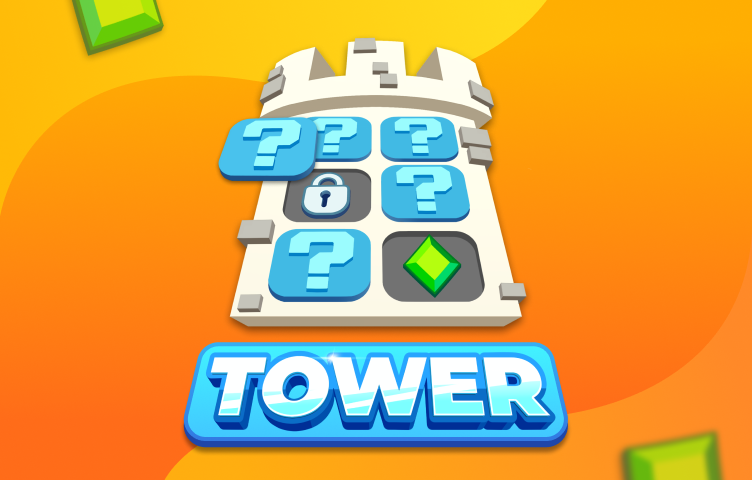Tower - Educational Risk Climbing Demo
Climb higher for bigger multipliers in this educational demo. Learn about progressive risk, the psychology of "just one more level," and how multiplier games create addiction.

Game Information
- Provider: InOut Games
- Release Date: 2024
- Game Type: Progressive Multiplier
- Demo RTP: 97.5%
- Volatility: High
- Levels: Up to 50
- Max Multiplier: 1,000,000x
- Difficulty: Easy, Normal, Hard
Demo version - No real money involved
About Tower Game
Tower is an educational demonstration of progressive risk and multiplier psychology in gambling. Players climb a virtual tower by selecting the correct block from multiple options at each level. Each successful level increases the multiplier, but one wrong choice ends the game and loses everything.
This game serves as an excellent educational tool to understand:
- How progressive risk creates psychological pressure to continue
- The "sunk cost fallacy" - continuing because you've already invested
- How multiplier games create addiction through escalating rewards
- The mathematics of compound probability in gambling
- Why "just one more level" thinking leads to significant losses
The game offers three difficulty levels that change the number of safe blocks per level: Easy mode has 3 safe blocks out of 4 (75% success rate), Normal has 2 out of 3 (66.7%), and Hard has 1 out of 2 (50%). As you climb higher, the cumulative probability of success decreases exponentially, but the potential rewards increase dramatically.
⚠️ Gambling Awareness Warning
This is a demo version for educational purposes only. Tower games are particularly dangerous because they create a false sense of skill and control, while exploiting the sunk cost fallacy. The escalating multipliers can be extremely addictive.
- Each level choice is random - there's no skill involved
- The probability of reaching high levels is extremely low
- The "just one more level" mentality leads to devastating losses
- Sunk cost fallacy makes players continue despite poor odds
- Seek help if you think you have a gambling problem
Tower Game Features
🏗️ Progressive Levels
Climb up to 50 levels with increasing multipliers, demonstrating how small wins can escalate into major risks.
🎯 Multiple Difficulty Modes
Choose Easy (75% success), Normal (66.7%), or Hard (50%) to see how odds affect risk and reward.
💰 Exponential Multipliers
Watch multipliers grow exponentially with each level, creating psychological pressure to continue climbing.
🎲 Random Block Selection
Each level's safe blocks are randomly positioned, ensuring no patterns or strategies can be developed.
📊 Real-time Probability
See your cumulative success probability decrease with each level, demonstrating compound risk.
🔄 Instant Cash Out
Cash out at any level to secure your current multiplier, teaching risk management principles.
How to Play Tower
- Choose Difficulty: Select Easy, Normal, or Hard mode to set the risk level
- Place Your Bet: Set your bet amount using demo credits (no real money)
- Start Climbing: Click on a block to reveal if it's safe or dangerous
- Continue or Cash Out: After each successful level, decide to climb higher or take your winnings
- Watch Your Multiplier: See your potential payout increase with each level
- Avoid the Trap: Hit a dangerous block and lose everything!
Difficulty Level Analysis
Easy Mode (3/4 safe)
- 75% success per level
- Level 10: 5.6% chance
- Level 20: 0.3% chance
- More consistent small wins
Normal Mode (2/3 safe)
- 66.7% success per level
- Level 10: 1.7% chance
- Level 20: 0.03% chance
- Balanced risk/reward
Hard Mode (1/2 safe)
- 50% success per level
- Level 10: 0.1% chance
- Level 20: 0.0001% chance
- Extreme risk, huge multipliers
🎓 Educational Objectives
- Experience how compound probability works against the player
- Understand the sunk cost fallacy in gambling contexts
- Learn why "just one more level" thinking is dangerous
- Recognize how escalating rewards create addiction
- Practice risk management and knowing when to stop
Understanding Tower Mathematics
Tower games demonstrate several important mathematical concepts:
Compound Probability
Success probability decreases exponentially:
Level N = (Success Rate)^N
Example: Normal mode Level 10 = (0.667)^10 = 1.7%
Expected Value
Despite high multipliers, expected value is negative:
- Easy Mode: ~97.5% RTP
- Normal Mode: ~97% RTP
- Hard Mode: ~96.5% RTP
The Sunk Cost Fallacy
Players often think: "I've already climbed 15 levels, I can't stop now!" But each level is an independent decision. The money already "invested" in previous levels is gone regardless of what you do next.
⚠️ The "Just One More" Trap
The most dangerous aspect of Tower games is the constant temptation to climb "just one more level." Each level seems achievable individually, but the cumulative risk is enormous. This is exactly how these games are designed to be addictive.
The Psychology Behind Tower Games
🧠 Escalation of Commitment
The more levels you climb, the harder it becomes to stop. Your brain focuses on the potential reward rather than the increasing risk.
💭 Illusion of Control
Choosing which block to click creates a false sense that skill is involved, when outcomes are purely random.
🎯 Near-Miss Effect
Getting close to high levels creates excitement and the feeling that big wins are "almost" achievable.
⚡ Variable Reward Schedule
Unpredictable wins at different levels create the strongest form of behavioral reinforcement.